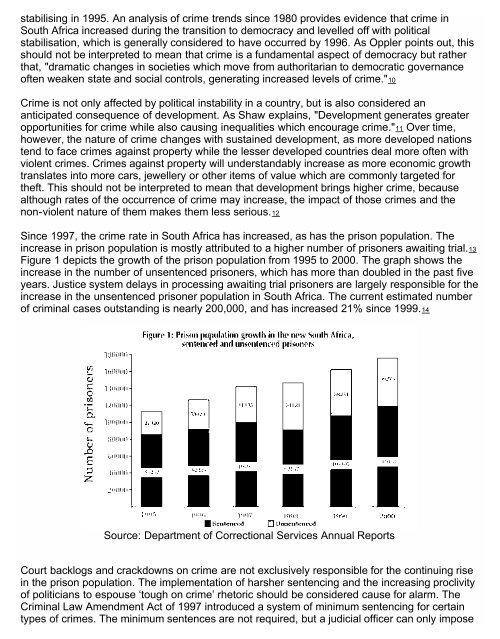prison privatisation in south africa issues, challenges and ...
prison privatisation in south africa issues, challenges and ...
prison privatisation in south africa issues, challenges and ...
You also want an ePaper? Increase the reach of your titles
YUMPU automatically turns print PDFs into web optimized ePapers that Google loves.
stabilis<strong>in</strong>g <strong>in</strong> 1995. An analysis of crime trends s<strong>in</strong>ce 1980 provides evidence that crime <strong>in</strong><br />
South Africa <strong>in</strong>creased dur<strong>in</strong>g the transition to democracy <strong>and</strong> levelled off with political<br />
stabilisation, which is generally considered to have occurred by 1996. As Oppler po<strong>in</strong>ts out, this<br />
should not be <strong>in</strong>terpreted to mean that crime is a fundamental aspect of democracy but rather<br />
that, "dramatic changes <strong>in</strong> societies which move from authoritarian to democratic governance<br />
often weaken state <strong>and</strong> social controls, generat<strong>in</strong>g <strong>in</strong>creased levels of crime."10<br />
Crime is not only affected by political <strong>in</strong>stability <strong>in</strong> a country, but is also considered an<br />
anticipated consequence of development. As Shaw expla<strong>in</strong>s, "Development generates greater<br />
opportunities for crime while also caus<strong>in</strong>g <strong>in</strong>equalities which encourage crime."11 Over time,<br />
however, the nature of crime changes with susta<strong>in</strong>ed development, as more developed nations<br />
tend to face crimes aga<strong>in</strong>st property while the lesser developed countries deal more often with<br />
violent crimes. Crimes aga<strong>in</strong>st property will underst<strong>and</strong>ably <strong>in</strong>crease as more economic growth<br />
translates <strong>in</strong>to more cars, jewellery or other items of value which are commonly targeted for<br />
theft. This should not be <strong>in</strong>terpreted to mean that development br<strong>in</strong>gs higher crime, because<br />
although rates of the occurrence of crime may <strong>in</strong>crease, the impact of those crimes <strong>and</strong> the<br />
non-violent nature of them makes them less serious.12<br />
S<strong>in</strong>ce 1997, the crime rate <strong>in</strong> South Africa has <strong>in</strong>creased, as has the <strong>prison</strong> population. The<br />
<strong>in</strong>crease <strong>in</strong> <strong>prison</strong> population is mostly attributed to a higher number of <strong>prison</strong>ers await<strong>in</strong>g trial.13<br />
Figure 1 depicts the growth of the <strong>prison</strong> population from 1995 to 2000. The graph shows the<br />
<strong>in</strong>crease <strong>in</strong> the number of unsentenced <strong>prison</strong>ers, which has more than doubled <strong>in</strong> the past five<br />
years. Justice system delays <strong>in</strong> process<strong>in</strong>g await<strong>in</strong>g trial <strong>prison</strong>ers are largely responsible for the<br />
<strong>in</strong>crease <strong>in</strong> the unsentenced <strong>prison</strong>er population <strong>in</strong> South Africa. The current estimated number<br />
of crim<strong>in</strong>al cases outst<strong>and</strong><strong>in</strong>g is nearly 200,000, <strong>and</strong> has <strong>in</strong>creased 21% s<strong>in</strong>ce 1999.14<br />
Source: Department of Correctional Services Annual Reports<br />
Court backlogs <strong>and</strong> crackdowns on crime are not exclusively responsible for the cont<strong>in</strong>u<strong>in</strong>g rise<br />
<strong>in</strong> the <strong>prison</strong> population. The implementation of harsher sentenc<strong>in</strong>g <strong>and</strong> the <strong>in</strong>creas<strong>in</strong>g proclivity<br />
of politicians to espouse ‘tough on crime’ rhetoric should be considered cause for alarm. The<br />
Crim<strong>in</strong>al Law Amendment Act of 1997 <strong>in</strong>troduced a system of m<strong>in</strong>imum sentenc<strong>in</strong>g for certa<strong>in</strong><br />
types of crimes. The m<strong>in</strong>imum sentences are not required, but a judicial officer can only impose
















